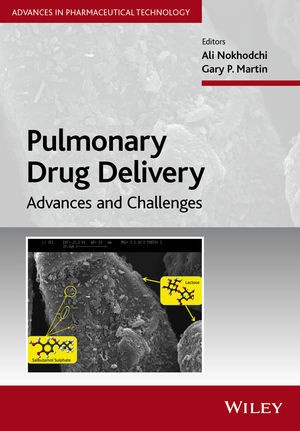Mehr lesen
Drug therapy via inhalation route is at the cutting edge of modern drug delivery research. There has been significant progress on the understanding of drug therapy via inhalation products. However, there are still problems associated with their formulation design, including the interaction between the active pharmaceutical ingredient(s) (APIs), excipients and devices. This book seeks to cover some of the most pertinent issues and challenges of such formulation design associated with industrial production and desirable clinical outcome.
The chapter topics have been selected with a view to integrating the factors that require consideration in the selection and design of device and formulation components which impact upon patient usability and clinical effectiveness. The challenges involved with the delivery of macromolecules by inhalation to both adult and pediatric patients are also covered.
Written by leading international experts from both academia and industry, the book will help readers (formulation design scientists, researchers and post-graduate and specialized undergraduate students) develop a deep understanding of key aspects of inhalation formulations as well as detail ongoing challenges and advances associated with their development.
Inhaltsverzeichnis
List of Contributors xiii
Series Preface xvii
Preface xix
1. Lung Anatomy and Physiology and Their Implications for Pulmonary Drug Delivery 1
Rahul K. Verma, Mariam Ibrahim, and Lucila Garcia-Contreras
1.1 Introduction 2
1.2 Anatomy and Physiology of Lungs 2
1.2.1 Macro- and Microstructure of the Airways and Alveoli as It Pertains to Drug Delivery 2
1.2.2 Lung Surfactant 4
1.2.3 Pulmonary Blood Circulation 5
1.3 Mechanisms of Aerosol Deposition 5
1.3.1 Impaction 6
1.3.2 Sedimentation 6
1.3.3 Interception 6
1.3.4 Diffusion 7
1.4 Drug Absorption 7
1.4.1 Mechanisms of Drug Absorption from the Lungs 7
1.5 Physiological Factors Affecting the Therapeutic Effectiveness of Drugs Delivered by the Pulmonary Route 8
1.5.1 Airway Geometry 8
1.5.2 Inhalation Mode 8
1.5.3 Airflow Rate 9
1.5.4 Mechanism of Particle Clearance 9
1.5.5 Lung Receptors 10
1.5.6 Disease States 11
1.5.7 Effect of Age and Gender Difference 11
1.6 Computer Simulations to Describe Aerosol Deposition in Health and Disease 11
1.6.1 Semiempirical Models 12
1.6.2 Deterministic Models 12
1.6.3 Trumpet Models (One-Dimensional) 12
1.6.4 Stochastic, Asymmetric Generation Models 13
1.6.5 Computation Fluid Dynamics (CFD)-Based Model 13
1.7 Conclusions 13
References 14
2. The Role of Functional Lung Imaging in the Improvement of Pulmonary Drug Delivery 19
Andreas Fouras and Stephen Dubsky
2.1 Introduction 19
2.1.1 Particle Deposition 20
2.1.2 Regional Action of Delivered Drug 22
2.1.3 The Role of Functional Lung Imaging in Pulmonary Drug Delivery 22
2.2 Established Functional Lung Imaging Technologies 23
2.2.1 Computed Tomography 23
2.2.2 Ventilation Measurement using 4DCT Registration-based Methods 24
2.2.3 Hyperpolarized Magnetic Resonance Imaging 24
2.2.4 Electrical Impedance Tomography 25
2.2.5 Nuclear Medical Imaging (PET/SPECT) 25
2.3 Emerging Technologies 26
2.3.1 Phase-contrast Imaging 26
2.3.2 Grating Interferometry 27
2.3.3 Propagation-based Phase-contrast Imaging 28
2.3.4 Functional Lung Imaging using Phase Contrast 28
2.3.5 Laboratory Propagation-based Phase-contrast Imaging 29
2.4 Conclusion 30
References 31
3. Dry Powder Inhalation for Pulmonary Delivery: Recent Advances and Continuing Challenges 35
Simone R. Carvalho, Alan B. Watts, Jay I. Peters, and Robert O. Williams III
3.1 Introduction 36
3.2 Dry Powder Inhaler Devices 37
3.2.1 Overview 37
3.2.2 Recent Innovations in Dry Powder Inhaler Technology 39
3.3 New Developments in DPI Formulations and Delivery 43
3.3.1 Particle Surface Modification 43
3.3.2 Particle Engineering Technology for Pulmonary Delivery 44
3.4 Characterization Methods of Dry Powder Inhaler Formulations 50
3.5 Conclusion 52
References 53
4. Pulmonary Drug Delivery to the Pediatric Population - A State-of-the-Art Review 63
Marie-Pierre Flament
4.1 Introduction 63
4.2 Patient Consideration 64
4.2.1 Anatomy and Physiology of Children's Lungs 64
4.2.2 Nasal Versus Oral Inhalation 65
4.2.3 Patient-related Factors Influencing Aerosol Deposition 66
4.2.4 Age and Dosage Forms of Choice 67
4.3 Delivery Systems for the Pediatric Population 69
4.3.1
Über den Autor / die Autorin
ALI NOKHODCHI School of Life Sciences, University of Sussex, UK
GARY P. MARTIN Institute of Pharmaceutical Science, King's College London, UK
Zusammenfassung
Drug therapy via inhalation route is at the cutting edge of modern drug delivery research. There has been significant progress on the understanding of drug therapy via inhalation products.

